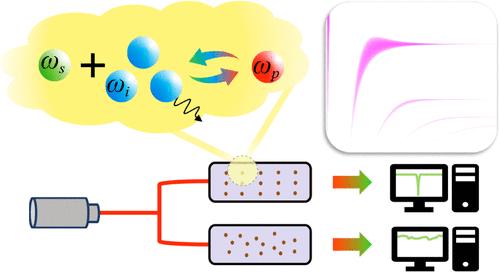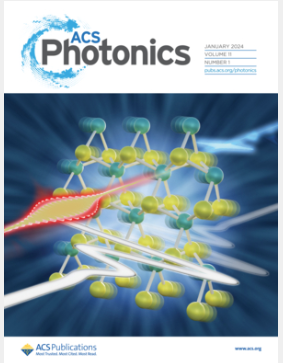Xiaoxiong Wu, Kai Bai, Penghong Yu, Zhaohui Dong, Yanyan He, Jingui Ma, Vladislav V. Yakovlev, Meng Xiao, Xianfeng Chen, Luqi Yuan
求助PDF
{"title":"研究准参数放大:从多重 PTPT 对称相变到非赫米提感应","authors":"Xiaoxiong Wu, Kai Bai, Penghong Yu, Zhaohui Dong, Yanyan He, Jingui Ma, Vladislav V. Yakovlev, Meng Xiao, Xianfeng Chen, Luqi Yuan","doi":"10.1021/acsphotonics.4c01071","DOIUrl":null,"url":null,"abstract":"Quasi-parametric amplification (QPA) is a nonlinear interaction in which the idler wave is depleted through a loss mechanism. QPA plays an important role in signal amplification in ultrafast photonics and quantum light generation. In this report, we explore the generalized features characterized by non-Hermitian parity-time (<i></i><span style=\"color: inherit;\"></span><span data-mathml='<math xmlns=\"http://www.w3.org/1998/Math/MathML\" display=\"inline\"><mi mathvariant=\"script\">PT</mi></math>' role=\"presentation\" style=\"position: relative;\" tabindex=\"0\"><nobr aria-hidden=\"true\"><span style=\"width: 2.154em; display: inline-block;\"><span style=\"display: inline-block; position: relative; width: 1.744em; height: 0px; font-size: 122%;\"><span style=\"position: absolute; clip: rect(1.386em, 1002em, 2.462em, -999.997em); top: -2.252em; left: 0em;\"><span><span style=\"font-family: MathJax_Script;\">PT</span></span><span style=\"display: inline-block; width: 0px; height: 2.257em;\"></span></span></span><span style=\"display: inline-block; overflow: hidden; vertical-align: -0.122em; border-left: 0px solid; width: 0px; height: 1.066em;\"></span></span></nobr><span role=\"presentation\"><math display=\"inline\" xmlns=\"http://www.w3.org/1998/Math/MathML\"><mi mathvariant=\"script\">PT</mi></math></span></span><script type=\"math/mml\"><math display=\"inline\"><mi mathvariant=\"script\">PT</mi></math></script>) symmetry in the QPA process and uncover multiple <i></i><span style=\"color: inherit;\"></span><span data-mathml='<math xmlns=\"http://www.w3.org/1998/Math/MathML\" display=\"inline\"><mi mathvariant=\"script\">PT</mi></math>' role=\"presentation\" style=\"position: relative;\" tabindex=\"0\"><nobr aria-hidden=\"true\"><span style=\"width: 2.154em; display: inline-block;\"><span style=\"display: inline-block; position: relative; width: 1.744em; height: 0px; font-size: 122%;\"><span style=\"position: absolute; clip: rect(1.386em, 1002em, 2.462em, -999.997em); top: -2.252em; left: 0em;\"><span><span style=\"font-family: MathJax_Script;\">PT</span></span><span style=\"display: inline-block; width: 0px; height: 2.257em;\"></span></span></span><span style=\"display: inline-block; overflow: hidden; vertical-align: -0.122em; border-left: 0px solid; width: 0px; height: 1.066em;\"></span></span></nobr><span role=\"presentation\"><math display=\"inline\" xmlns=\"http://www.w3.org/1998/Math/MathML\"><mi mathvariant=\"script\">PT</mi></math></span></span><script type=\"math/mml\"><math display=\"inline\"><mi mathvariant=\"script\">PT</mi></math></script>-symmetric phase transitions in such a QPA process in which transitions are ultrasensitive to external parameters. In particular, we demonstrate the feasibility of detection of 10<sup>–11</sup> inhomogeneities of the doped absorber, which is several orders of magnitude more sensitive than similar measurements performed in a linear absorption regime. In doing so, we reveal a family of <i></i><span style=\"color: inherit;\"></span><span data-mathml='<math xmlns=\"http://www.w3.org/1998/Math/MathML\" display=\"inline\"><mi mathvariant=\"script\">PT</mi></math>' role=\"presentation\" style=\"position: relative;\" tabindex=\"0\"><nobr aria-hidden=\"true\"><span style=\"width: 2.154em; display: inline-block;\"><span style=\"display: inline-block; position: relative; width: 1.744em; height: 0px; font-size: 122%;\"><span style=\"position: absolute; clip: rect(1.386em, 1002em, 2.462em, -999.997em); top: -2.252em; left: 0em;\"><span><span style=\"font-family: MathJax_Script;\">PT</span></span><span style=\"display: inline-block; width: 0px; height: 2.257em;\"></span></span></span><span style=\"display: inline-block; overflow: hidden; vertical-align: -0.122em; border-left: 0px solid; width: 0px; height: 1.066em;\"></span></span></nobr><span role=\"presentation\"><math display=\"inline\" xmlns=\"http://www.w3.org/1998/Math/MathML\"><mi mathvariant=\"script\">PT</mi></math></span></span><script type=\"math/mml\"><math display=\"inline\"><mi mathvariant=\"script\">PT</mi></math></script>-symmetric phase transitions appearing in the QPA process and provide a distinctive nonlinear optical sensing mechanism for precise optical measurements.","PeriodicalId":23,"journal":{"name":"ACS Photonics","volume":"14 1","pages":""},"PeriodicalIF":6.7000,"publicationDate":"2024-10-09","publicationTypes":"Journal Article","fieldsOfStudy":null,"isOpenAccess":false,"openAccessPdf":"","citationCount":"0","resultStr":"{\"title\":\"Studying Quasi-Parametric Amplifications: From Multiple PTPT -Symmetric Phase Transitions to Non-Hermitian Sensing\",\"authors\":\"Xiaoxiong Wu, Kai Bai, Penghong Yu, Zhaohui Dong, Yanyan He, Jingui Ma, Vladislav V. Yakovlev, Meng Xiao, Xianfeng Chen, Luqi Yuan\",\"doi\":\"10.1021/acsphotonics.4c01071\",\"DOIUrl\":null,\"url\":null,\"abstract\":\"Quasi-parametric amplification (QPA) is a nonlinear interaction in which the idler wave is depleted through a loss mechanism. QPA plays an important role in signal amplification in ultrafast photonics and quantum light generation. In this report, we explore the generalized features characterized by non-Hermitian parity-time (<i></i><span style=\\\"color: inherit;\\\"></span><span data-mathml='<math xmlns=\\\"http://www.w3.org/1998/Math/MathML\\\" display=\\\"inline\\\"><mi mathvariant=\\\"script\\\">PT</mi></math>' role=\\\"presentation\\\" style=\\\"position: relative;\\\" tabindex=\\\"0\\\"><nobr aria-hidden=\\\"true\\\"><span style=\\\"width: 2.154em; display: inline-block;\\\"><span style=\\\"display: inline-block; position: relative; width: 1.744em; height: 0px; font-size: 122%;\\\"><span style=\\\"position: absolute; clip: rect(1.386em, 1002em, 2.462em, -999.997em); top: -2.252em; left: 0em;\\\"><span><span style=\\\"font-family: MathJax_Script;\\\">PT</span></span><span style=\\\"display: inline-block; width: 0px; height: 2.257em;\\\"></span></span></span><span style=\\\"display: inline-block; overflow: hidden; vertical-align: -0.122em; border-left: 0px solid; width: 0px; height: 1.066em;\\\"></span></span></nobr><span role=\\\"presentation\\\"><math display=\\\"inline\\\" xmlns=\\\"http://www.w3.org/1998/Math/MathML\\\"><mi mathvariant=\\\"script\\\">PT</mi></math></span></span><script type=\\\"math/mml\\\"><math display=\\\"inline\\\"><mi mathvariant=\\\"script\\\">PT</mi></math></script>) symmetry in the QPA process and uncover multiple <i></i><span style=\\\"color: inherit;\\\"></span><span data-mathml='<math xmlns=\\\"http://www.w3.org/1998/Math/MathML\\\" display=\\\"inline\\\"><mi mathvariant=\\\"script\\\">PT</mi></math>' role=\\\"presentation\\\" style=\\\"position: relative;\\\" tabindex=\\\"0\\\"><nobr aria-hidden=\\\"true\\\"><span style=\\\"width: 2.154em; display: inline-block;\\\"><span style=\\\"display: inline-block; position: relative; width: 1.744em; height: 0px; font-size: 122%;\\\"><span style=\\\"position: absolute; clip: rect(1.386em, 1002em, 2.462em, -999.997em); top: -2.252em; left: 0em;\\\"><span><span style=\\\"font-family: MathJax_Script;\\\">PT</span></span><span style=\\\"display: inline-block; width: 0px; height: 2.257em;\\\"></span></span></span><span style=\\\"display: inline-block; overflow: hidden; vertical-align: -0.122em; border-left: 0px solid; width: 0px; height: 1.066em;\\\"></span></span></nobr><span role=\\\"presentation\\\"><math display=\\\"inline\\\" xmlns=\\\"http://www.w3.org/1998/Math/MathML\\\"><mi mathvariant=\\\"script\\\">PT</mi></math></span></span><script type=\\\"math/mml\\\"><math display=\\\"inline\\\"><mi mathvariant=\\\"script\\\">PT</mi></math></script>-symmetric phase transitions in such a QPA process in which transitions are ultrasensitive to external parameters. In particular, we demonstrate the feasibility of detection of 10<sup>–11</sup> inhomogeneities of the doped absorber, which is several orders of magnitude more sensitive than similar measurements performed in a linear absorption regime. In doing so, we reveal a family of <i></i><span style=\\\"color: inherit;\\\"></span><span data-mathml='<math xmlns=\\\"http://www.w3.org/1998/Math/MathML\\\" display=\\\"inline\\\"><mi mathvariant=\\\"script\\\">PT</mi></math>' role=\\\"presentation\\\" style=\\\"position: relative;\\\" tabindex=\\\"0\\\"><nobr aria-hidden=\\\"true\\\"><span style=\\\"width: 2.154em; display: inline-block;\\\"><span style=\\\"display: inline-block; position: relative; width: 1.744em; height: 0px; font-size: 122%;\\\"><span style=\\\"position: absolute; clip: rect(1.386em, 1002em, 2.462em, -999.997em); top: -2.252em; left: 0em;\\\"><span><span style=\\\"font-family: MathJax_Script;\\\">PT</span></span><span style=\\\"display: inline-block; width: 0px; height: 2.257em;\\\"></span></span></span><span style=\\\"display: inline-block; overflow: hidden; vertical-align: -0.122em; border-left: 0px solid; width: 0px; height: 1.066em;\\\"></span></span></nobr><span role=\\\"presentation\\\"><math display=\\\"inline\\\" xmlns=\\\"http://www.w3.org/1998/Math/MathML\\\"><mi mathvariant=\\\"script\\\">PT</mi></math></span></span><script type=\\\"math/mml\\\"><math display=\\\"inline\\\"><mi mathvariant=\\\"script\\\">PT</mi></math></script>-symmetric phase transitions appearing in the QPA process and provide a distinctive nonlinear optical sensing mechanism for precise optical measurements.\",\"PeriodicalId\":23,\"journal\":{\"name\":\"ACS Photonics\",\"volume\":\"14 1\",\"pages\":\"\"},\"PeriodicalIF\":6.7000,\"publicationDate\":\"2024-10-09\",\"publicationTypes\":\"Journal Article\",\"fieldsOfStudy\":null,\"isOpenAccess\":false,\"openAccessPdf\":\"\",\"citationCount\":\"0\",\"resultStr\":null,\"platform\":\"Semanticscholar\",\"paperid\":null,\"PeriodicalName\":\"ACS Photonics\",\"FirstCategoryId\":\"101\",\"ListUrlMain\":\"https://doi.org/10.1021/acsphotonics.4c01071\",\"RegionNum\":1,\"RegionCategory\":\"物理与天体物理\",\"ArticlePicture\":[],\"TitleCN\":null,\"AbstractTextCN\":null,\"PMCID\":null,\"EPubDate\":\"\",\"PubModel\":\"\",\"JCR\":\"Q1\",\"JCRName\":\"MATERIALS SCIENCE, MULTIDISCIPLINARY\",\"Score\":null,\"Total\":0}","platform":"Semanticscholar","paperid":null,"PeriodicalName":"ACS Photonics","FirstCategoryId":"101","ListUrlMain":"https://doi.org/10.1021/acsphotonics.4c01071","RegionNum":1,"RegionCategory":"物理与天体物理","ArticlePicture":[],"TitleCN":null,"AbstractTextCN":null,"PMCID":null,"EPubDate":"","PubModel":"","JCR":"Q1","JCRName":"MATERIALS SCIENCE, MULTIDISCIPLINARY","Score":null,"Total":0}
引用次数: 0
引用
批量引用


 求助内容:
求助内容: 应助结果提醒方式:
应助结果提醒方式:


